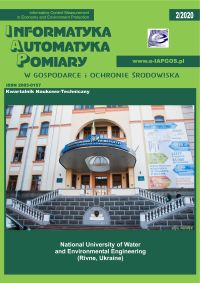DESIGN OF MULTIFUNCTION SIMULATOR FOR ENGINE ROOM PERSONNEL TRAINING
Article Sidebar
Open full text
Issue Vol. 10 No. 2 (2020)
-
TRANSISTOR-BASED TEMPERATURE MEASURING DEVICE
Oleksandra Hotra4-7
-
ANALYSIS OF ALL-PASS FILTERS APPLICATION TO ELIMINATE NEGATIVE EFFECTS OF LOUDNESS WAR TREND
Marcin Maciejewski, Wojciech Surtel, Krzysztof Nowak8-11
-
LOGICAL CLASSIFICATION TREES IN RECOGNITION PROBLEMS
Igor Povhan12-15
-
RANKING OF WEBSITES CREATED WITH THE USE OF ISOWQ RANK ALGORITHM
Mariusz Duka16-19
-
OVERVIEW OF BROADBAND INFORMATION SYSTEMS ARCHITECTURE FOR CRISIS MANAGEMENT
Jacek Wilk-Jakubowski20-23
-
TIME-VARIANT MODEL OF HEAT-AND-MASS EXCHANGE FOR STEAM HUMIDIFIER
Igor Golinko, Volodymyr Drevetskiy24-27
-
NONSTATIONARY HEAT CONDUCTION IN MULTILAYER GLAZING SUBJECTED TO DISTRIBUTED HEAT SOURCES
Natalia Smetankina, Oleksii Postnyi28-31
-
REAL-TIME MONITORING OF CELL CULTURES WITH NICKEL COMB CAPACITORS
Andrzej Kociubiński, Dawid Zarzeczny, Maciej Szypulski, Aleksandra Wilczyńska, Dominika Pigoń, Teresa Małecka-Massalska, Monika Prendecka32-35
-
AN OVERVIEW OF CLASSIFICATION METHODS FROM DERMOSCOPY IMAGES IN SKIN LESION DIAGNOSTIC
Magdalena Michalska, Oksana Boyko36-39
-
SOFTWARE DEVELOPMENT FOR SMART HOME PROCESS CONTROL
Vitalii Kopeliuk, Vira Voronytska, Volodymyr Havryliuk40-43
-
EXERGY-BASED CONTROL STRATEGY IN A DWELLING VENTILATION SYSTEM WITH HEAT RECOVERY
Volodymyr Voloshchuk, Mariya Polishchuk44-47
-
ANALYSIS OF THE ELECTRICITY METERING SYSTEM FOR OWN ELECTRIC SUBSTATION NEEDS
Sergiy Stets, Andriy Stets48-51
-
RESEARCH ON THE COMBUSTION PROCESS USING TIME SERIES
Żaklin Grądz52-55
-
RESEARCH AND SIMULATION OF THE LOCAL NAVIGATION SYSTEM OF TERRESTRIAL MOBILE ROBOT
Andrii Rudyk, Viktoriia Rudyk, Mykhailo Matei56-61
-
DESIGN OF MULTIFUNCTION SIMULATOR FOR ENGINE ROOM PERSONNEL TRAINING
Artem Ivanov, Igor Kolosov, Vadim Danyk, Sergey Voronenko, Yurii Lebedenko, Hanna Rudakova62-69
-
MODEL PREDICTIVE CONTROL APPLICATION IN THE ENERGY SAVING TECHNOLOGY OF BASIC OXYGEN FURNACE
Oleksandr Stepanets, Yurii Mariiash70-74
Archives
-
Vol. 12 No. 4
2022-12-30 16
-
Vol. 12 No. 3
2022-09-30 15
-
Vol. 12 No. 2
2022-06-30 16
-
Vol. 12 No. 1
2022-03-31 9
-
Vol. 11 No. 4
2021-12-20 15
-
Vol. 11 No. 3
2021-09-30 10
-
Vol. 11 No. 2
2021-06-30 11
-
Vol. 11 No. 1
2021-03-31 14
-
Vol. 10 No. 4
2020-12-20 16
-
Vol. 10 No. 3
2020-09-30 22
-
Vol. 10 No. 2
2020-06-30 16
-
Vol. 10 No. 1
2020-03-30 19
-
Vol. 9 No. 4
2019-12-16 20
-
Vol. 9 No. 3
2019-09-26 20
-
Vol. 9 No. 2
2019-06-21 16
-
Vol. 9 No. 1
2019-03-03 13
-
Vol. 8 No. 4
2018-12-16 16
-
Vol. 8 No. 3
2018-09-25 16
-
Vol. 8 No. 2
2018-05-30 18
-
Vol. 8 No. 1
2018-02-28 18
Main Article Content
DOI
Authors
Abstract
International requirements for improving energy efficiency and environmental protection and the necessary goals for their implementation in the marine industry are an actual problem. To integrate state-of-the-industry technologies and marine specialists education, the training complex is proposed. It is based on the platform of a hardware-software complex with the ability to integrate training equipment, simulators and software. That makes such a training complex multitask, universal, and flexible in achieving a variety of tasks and goals. The complex also implements high-quality education and training of marine specialists, conducting research after processing working out the results of engineering modelling of structural, thermal power, hydraulic, electrical, electronic, multi-physical and other solutions. The need to use the training complex allows us to form the necessary competence of the engine team personnel, develop methods and criteria for assessing competence, evaluate and demonstrate practical skills.
Keywords:
References
Geertsma R., Negenborn R., Hopman J.: Design and control of hybrid power and propulsion systems for smart ships: A review of developments. Elsevier 2017. DOI: https://doi.org/10.1016/j.apenergy.2017.02.060
Ivanov A.A., Lebedenko Yu.A., Rozhkov S.A., Kolosov I.V.: Electric Propulsion Ship’s Training Simulator Based on Intelligent system. International scientific journal Electronics and Control Systems 2(60), 2019, 53–60. DOI: https://doi.org/10.18372/1990-5548.60.13815
Kuznetsov M., Rudakova H., Kolosov I.: The application of fuzzy logic to identify the personal state of the human operator. Computer-integrated technologies in the present: a collection of scientific works of young scientists, Kherson 2016, 15–19.
DNV GL Standard. DNVGL-ST-0033. Maritime simulator systems. Edition: March 2017.
IMO: International Convention on Standards of Training, Certification and Watchkeeping for Seafarers, (STCW Code). London 2017.
IMO: Marpol, AnnexVI and NTC 2008. London 2017.
IMO: Marpol. London, 2017.
IMO: MEPC 63/23 Annex9. London 2012.
IMO: Model Course 2.07 Engine-Room Simulator. London 2017.
IMO: Model Course 4.05 Energy Efficiency Operation of ship. London 2014.
IMO: Model Course 7.02 Chief Engineer Officer and Second Engineer Officer. London 2014.
IMO: Model Course 7.04 Officer in Charge of an Engineering Watch. London 2014.
IMO: Model Course 7.08 Electro-Technical Officer. London 2014.
https://www.kongsberg.com/digital/products/maritime-simulation/k-sim-engine/ (available 26.01.2020).
https://www.pgs.com/marine-acquisition/tools-and-techniques/the-fleet/ (available 26.01.2020).
https://www.se.com/ww/en/product-range-presentation/2714-somove/#tabs-top (available 26.01.2020).
https://www.wartsila.com/marine/optimise/simulation-and-training (available 26.01.2020).
Article Details
Abstract views: 777
License

This work is licensed under a Creative Commons Attribution-ShareAlike 4.0 International License.






